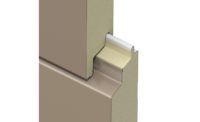What do a pueblo-style, K-8 school of the Zuni Tribe in New Mexico and an ultra-modern, single-family residence in California have in common?
Answer: Both are examples of the design flexibility provided by Structural Insulated Panels. Building professionals are using the panels to create high-performance building envelopes in a wide variety of architectural styles for homes and commercial/institutional buildings.
Further displaying the design possibilities, architects and builders currently are employing SIPs in a number of atypical applications, such as:
- A zero net energy cabin
- A floating home
- Supplemental rooms designed for backyards
Zero Net Energy Cabin
Modern, energy-efficient cabins are worlds apart from the notoriously drafty log-built structures the pioneers lived in.
In the Methow Valley of Washington state, a group of outdoor enthusiasts is building an ultra-energy-efficient home as a base for their skiing, climbing and hiking adventures in the Cascade Mountains. Designed for zero net energy status, the SIP-built Artemesia cabin achieved 0.5 air changes per hour in a blower door test, which surpasses the strict Passive House standard of 0.6 ACH.
The project team chose SIPs because the panels “afford the high degree of insulation and air tightness needed to meet our net-zero goal.” In addition to triple-pane windows, the SIPs provide a high-performance building envelope that will enable the cabin to operate solely from on-site solar electricity, without reliance on gas, wood or other fuels.
To further enhance energy efficiency, the cabin uses Platinum SIPs from Premier Building Systems, which are made with a new class of insulation called graphite polystyrene (see “SIPs ‘Go Gray’,” Walls & Ceilings, November 2016 Issue). The graphite infused insulation provides 20 percent or higher R-values than traditional SIPs.
Floating home
While building professionals typically choose SIPs for the panels’ high-energy efficiency and speed of construction, Arnold Industries adds lower weight to that list. The Portland, Ore.-based company is building a “Float Home” in the city using SIPs for the walls and roof. Although SIPs are stronger than stick framing, they weigh significantly less.
Compared to a conventionally framed structure, Arnold Industries is able to reduce the number of float blocks needed to support the water-borne home from 350-450 blocks to 140-150. The approximately 60 percent reduction needed in float blocks will save the builder an estimated $27,000 to $40,500.
Supplemental rooms designed for backyards
Award-winning designer and inventor, Charles Sidi, has developed a patent-pending concept for small site-built spaces he calls Yardhaus. The rooms are intended to reduce the time it takes to build dramatically. The 24-feet by 16-feet structures, with an integrated deck, can be stand alone or connected to existing buildings. Sidi anticipates popular uses will include home offices and gyms, as well as yoga studios, game rooms and guesthouses. Designed to be completed in only three weeks from installation of a concrete foundation, Sidi chose SIPs for their high-energy efficiency and ability to shorten construction schedules.
Conclusion
Virtually any style building can be designed from the ground-up using SIPs or existing designs can be converted to SIP construction. In either case, panels arrive at the job site pre-cut to the design drawings. Leading SIP manufacturers can even cut curved sections on panel tops or edges, along with pre-cutting arched door and window openings – which further expands the design possibilities and streamlines construction.







Report Abusive Comment